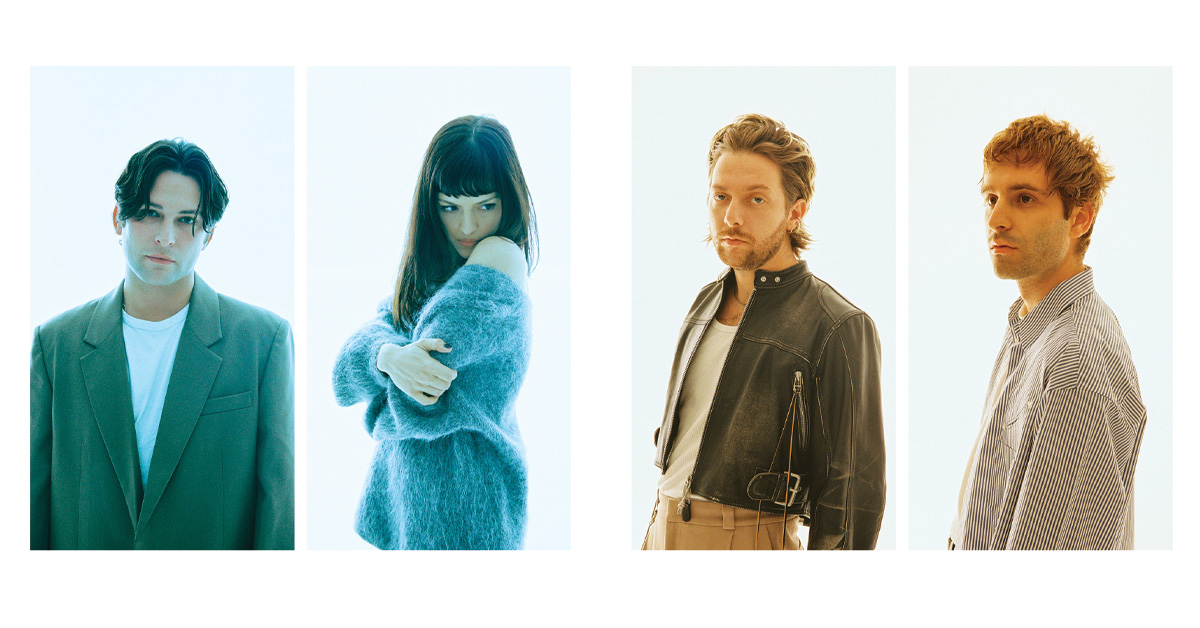
Those Who Knock: Doldrum Discuss Their Haunted, Peculiar Black Metal (Interview)
Doldrum‘s May 2022 debut was one of last year’s most celebrated albums among our year-end lists. The Knocking, Or The Story of the Sound that Preceded Their Disappearance is an old wive’s tale of a black metal album, a ghastly recollection of a superstitious encounter set in the 1800s. Doldrum’s take on horror discards shock value in favor of unreliable narrators, exaggerated reactions, and antiquated beliefs belonging to the story’s setting, an America from centuries past. Musically, the Colorado group pull just as liberally from artsy metal projects as they do the “Denver” sound, an alt-country style brimming with grim subject matter and croaking vocals. However, they’re not nearly as esoteric as they appear. The Knocking is quite accessible, in fact, boasting a spacious production and sticky percussion, opening up what would otherwise be an off-kilter affair to unsuspecting listeners.
Band members The Terrific Don McKinnon, Jimmy Oh-My-Back, and Rat Deveaux were gracious enough to speak with us, revealing the design principles informing The Knocking, Or The Story of the Sound that Preceded Their Disappearance. Their thoughtfulness seeps outwards as they detailed their thoughts on the intersection between camp and horror, American folk horror, and more, below.
…
…
In your interview with From the Bowels of Perdition, you bring up something that’s vital to metal–camp. However, The Knocking, Or The Story of the Sound that Preceded Their Disappearance doesn’t sound overtly campy, so I’m interested in knowing how you injected camp into it or how it guided your process.
Rat Deveaux: I despise art that reaches for the purely sincere (the New Sincerity, etc.), and would argue, at least from the mid-twentieth century on, that a sense of ironic distance is de facto required for any work to be capital-A Art. We talk about this in literature and film and the visual arts ad nauseam, and of course it applies to music as well. In the gospel of the subject, Notes on Camp, [Susan] Sontag emphasizes artifice, shocking excess, and bad taste, which sounds an awful lot like black metal to me! Maybe it’s because I focus on the vocals and the lyrics and by extension the concept and image-making, but you can’t wail about a haunting or stage a photo wearing corpse paint without cracking a smile. And where do you go after the album is done, and the shows are over, and you’ve washed off all the makeup? Back to work your IT job, or read to your kid before bed, or make a salad. The irony is inherent to the form, to the push-pull between our bourgeois lives and the black metal fantastique: campy and scary and affecting. All good Art is a heady mix of affects. The road to pure sincerity is littered with madmen and suicides: just look at David Foster Wallace and Dead.
I 100% agree with you about irony. That’s what attracted me to black metal–the self-awareness necessary to balance the camp and the shock. Do you believe black metal has a higher ceiling for camp and performativity because it’s so extreme by nature?
Rat: Art that tends towards extremity can create camp’s necessary disjunction between the everyday and the unreal, irreal, surreal, etc.–a productive gap in which irony and self-awareness tend to flourish. Black metal is fascinating (and difficult) because it often attracts adolescents and ideologues, both who tend to take things at face value; and by the nature of the music and images’ unique extremity, when that gap collapses–and a sense of self-awareness doesn’t come into the fold–the outcomes can be extreme: fascism, suicide, murder. We hear from the hardliners that danger is inherent to the genre; and while I agree in some specific eras and scenes, this misses the many-headed form that black metal has taken since the very beginning: some vicious and hateful, some gothic and romantic, some weird and wyrding. One need only look to the Czech gods, Master’s Hammer, there at the crack of the egg, charting a path of their own. Naturally, we’re interested in something like this other path.
On that note, your album is horror-based, and people find it hard to balance camp and horror while retaining the merits of both. How did you maintain your atmosphere while balancing the lack of self-seriousness?
Rat: I don’t think the two are in tension at all. Horror and camp are kissing cousins. Camp has been coded into our sense of modern horror since at least the 60s; e.g. think about the stilted/mannered performances in CARNIVAL OF SOULS, or the “bad taste” of NIGHT OF THE LIVING DEAD. When self-awareness replaces self-seriousness, camp and horror can become indistinguishable. But my two-word and final answer on the subject is David Lynch.
You’ve spoken about your production and selecting a cleaner style as opposed to cloudy, raw black metal. Normally a story about the fear of the unknown, or a haunted black metal album, would select a murkier production. How do you think the story and atmosphere benefited from a crisp production?
The Terrific Don McKinnon: We wanted the production to sound jangly and percussive with a prominent rhythm section. In some aspects, the sound we were going for has more in common with 90s alternative rock than what you’d expect. Mainly it was just about servicing the songs rather than cultivating atmosphere in post. The songs themselves should deliver the atmosphere.
Jimmy Oh-My-Back: Murky production to convey atmosphere has always seemed a bit lazy to me. The music comes first–write songs that illuminate the feeling, and have the production work around that. We felt that a punchy, clear sound would benefit this material best.
Doldrum has a similar dusty American sound as other Denver acts such as 16 Horsepower, though you obviously work in different styles. How do you transfer the American spirit housed in those bands to Doldrum?
Jimmy: Though Rat and I are not originally from here, the environment in Colorado has an impact on me personally. The nature is astounding, but there’s an atmosphere of grime within the urban surroundings. You can still get a sense of frontier here; a kind of borderland where that flat dusty land erupts into tremendous jagged rock. 16 Horsepower is undoubtedly an influence on Doldrum, and the first time that I was in the mountains listening to them was an incredible experience. One of those rare instances where the space the music truly synced.
Don: Single coil pickups!
The Knocking, Or The Story of the Sound that Preceded Their Disappearance is a very American-sounding album, drawing from Western music rather than the west. You have a quote that summarizes this perfectly–”Put another way, we’re less interested in America than we are in Americana.” Is there a notion to explore the American mythos rather than the “true” America?
Rat: I’m not quite sure how one can read the West, or a “true” America, as a priori subjects. We draw on the sounds and images and languages of the West–and a haunted Americana writ large–as inspiration for our own color of folk horror. An American mythos exists, absolutely, to explore, investigate, plumb, all that. A “true” America is the real fiction. We’ve only got the map to follow; the territory is inscrutable, and likely violent and ugly.
Jimmy: To elaborate some, we are in no way seeking to pursue some American ideal. Our approach to Americana is via an intrigue with the artifacts of culture. The Knocking is merely our reflection on some of these abnormal artifacts.
Were there particular American spiritual myths and stories you drew from?
Jimmy: We drew enormous inspiration from 19th century spiritualism. The Fox sisters and the culture surrounding table rapping and seances are a peculiar example. The ideas of Mesmer, Swedenborg, and Theosophy all stretched their limbs into the country around this time and there was a flourishing of belief in the bizarre and esoteric. The country in its infancy was such a hotbed for religious reform, and the rapid changes allowed for the esoteric to seep in with greater impact. This reform birthed new spiritual approaches that we decided to conflate with the severe isolation of rural life and folklore.
Don: Miner lore and stuff we like to think 1800s miners believed and feared: Tommyknockers, Inner Earth, actual miner culture and spiritualism.
One facet I love about your record is that every track has a different voice, not in terms of actual vocals but in diction and manner of speaking. I get that these represent different characters, but how did the way each one speaks dictate their personality, or vice versa?
Rat: I’ve said it elsewhere, but when I write, the form dictates the content. The lyrics and vocals have to find their place in the music, and shouldn’t be wedged in for vanity’s sake. So the personalities of the different speakers arrive, in some sense, from the sounds of the riffs and rhythms, and the spaces created for speaking. Naturally, once the narrative began to take shape, we adjusted the tone and style to fit the story, with new voices cracking through, some making their exit; but the music comes first and foremost, always.
…
The Knocking, Or The Story of the Sound that Preceded Their Disappearance is out now via Katafalque.










